Micro Economics: Analysis of Hand Sanitizers
VerifiedAdded on 2022/12/27
|8
|2088
|61
AI Summary
This report analyzes the micro-economic standpoint behind the recent purchase of hand sanitizers, including factors influencing supply and demand, pricing, and elasticity of the product.
Contribute Materials
Your contribution can guide someone’s learning journey. Share your
documents today.
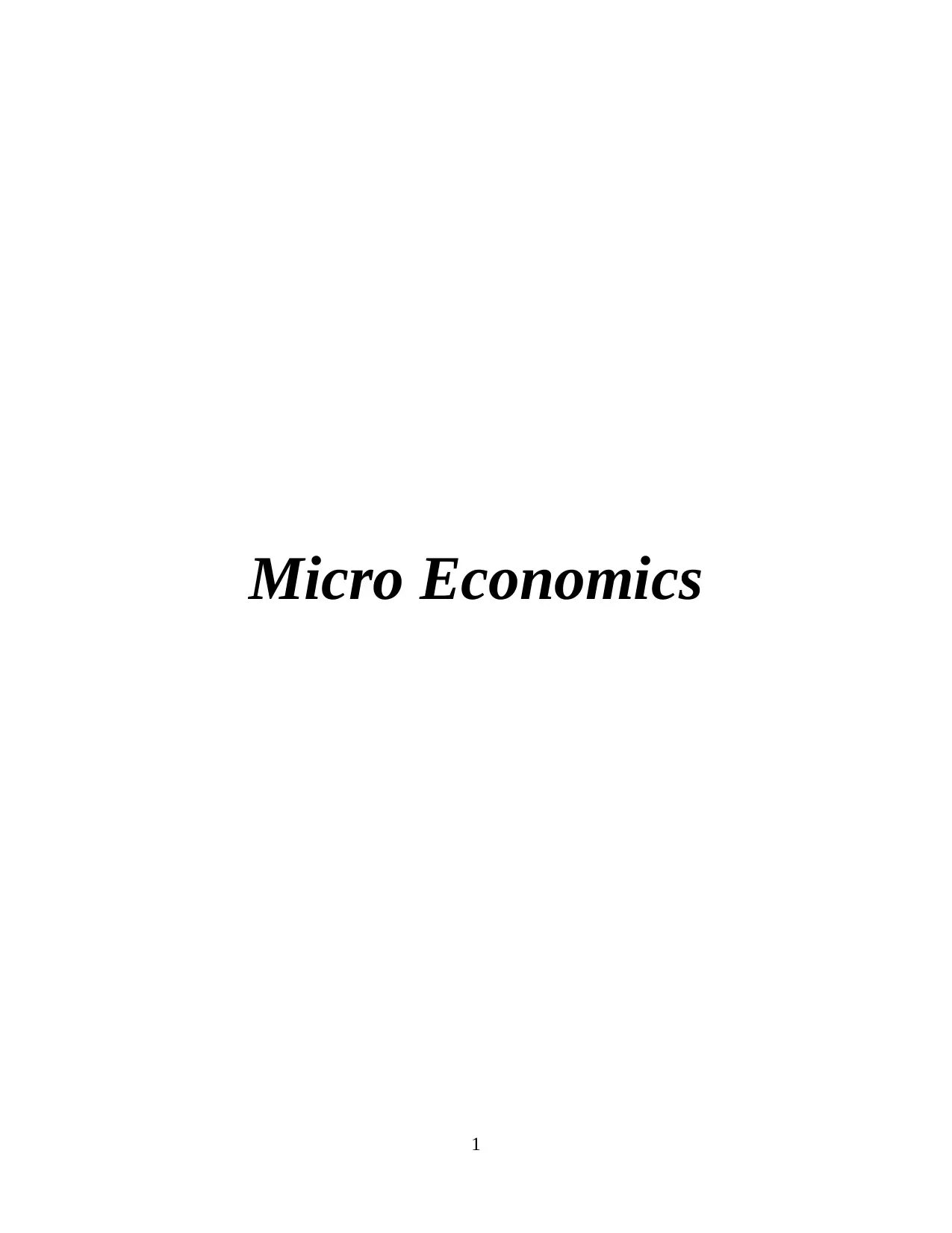
Micro Economics
1
1
Secure Best Marks with AI Grader
Need help grading? Try our AI Grader for instant feedback on your assignments.
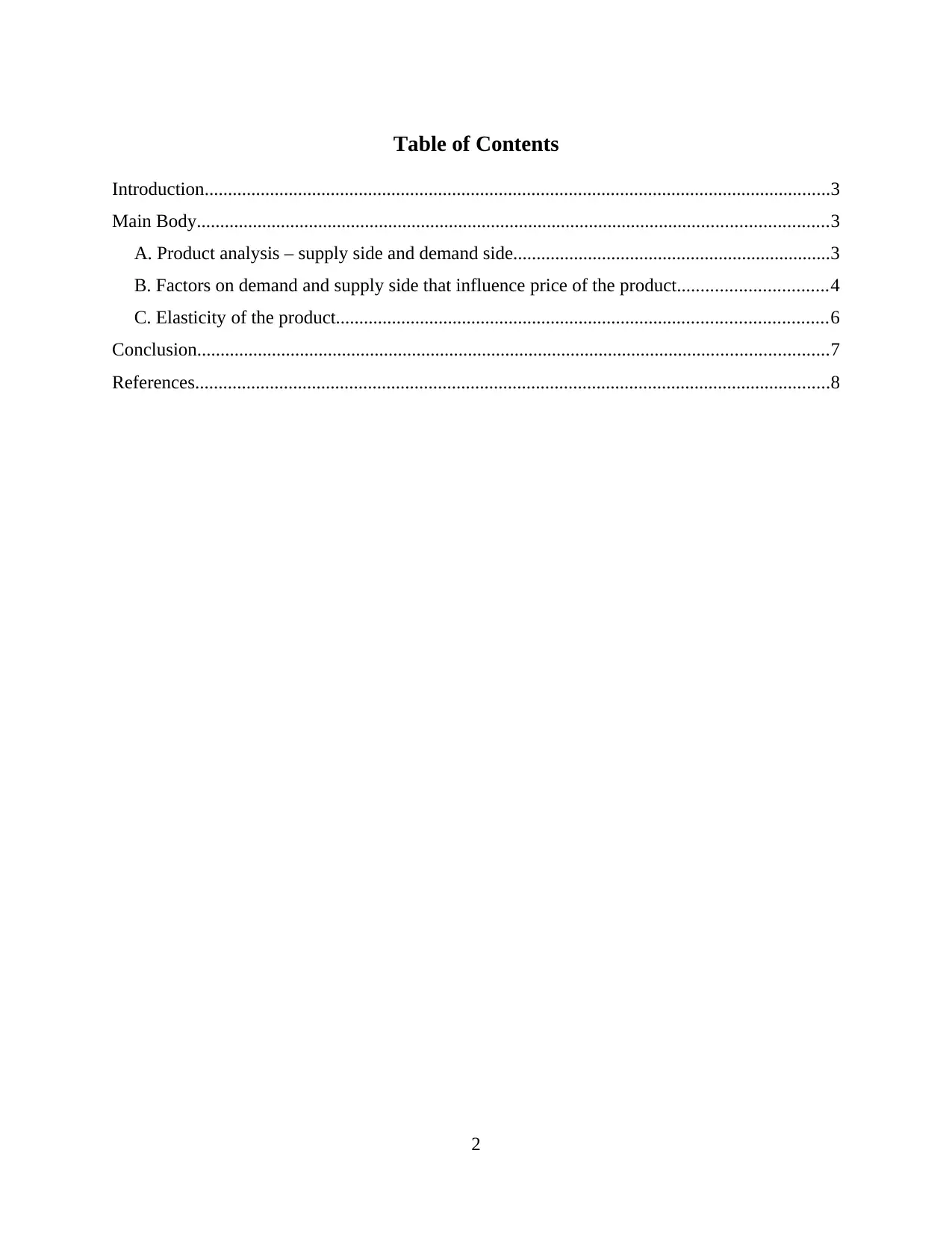
Table of Contents
Introduction......................................................................................................................................3
Main Body.......................................................................................................................................3
A. Product analysis – supply side and demand side....................................................................3
B. Factors on demand and supply side that influence price of the product................................4
C. Elasticity of the product.........................................................................................................6
Conclusion.......................................................................................................................................7
References........................................................................................................................................8
2
Introduction......................................................................................................................................3
Main Body.......................................................................................................................................3
A. Product analysis – supply side and demand side....................................................................3
B. Factors on demand and supply side that influence price of the product................................4
C. Elasticity of the product.........................................................................................................6
Conclusion.......................................................................................................................................7
References........................................................................................................................................8
2
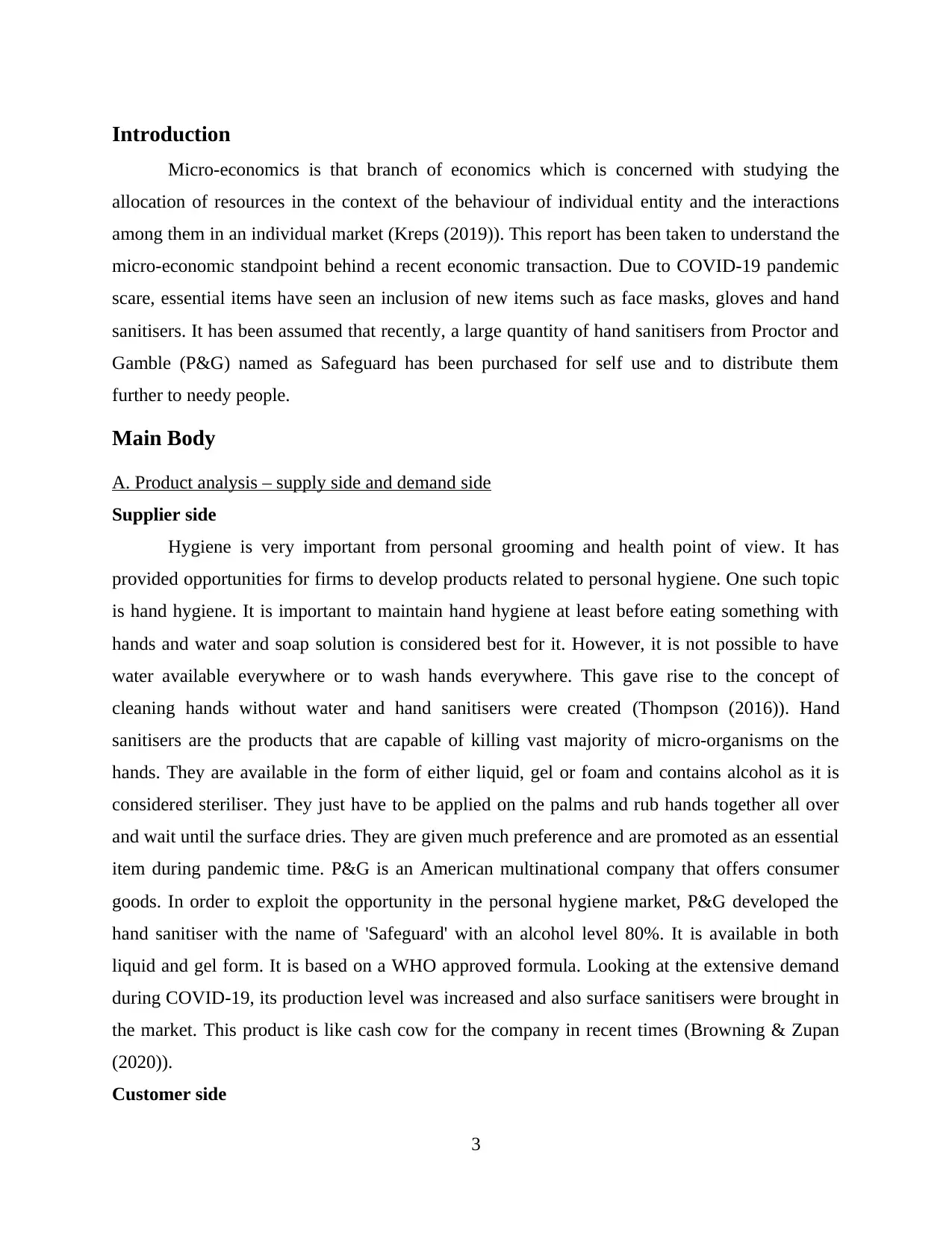
Introduction
Micro-economics is that branch of economics which is concerned with studying the
allocation of resources in the context of the behaviour of individual entity and the interactions
among them in an individual market (Kreps (2019)). This report has been taken to understand the
micro-economic standpoint behind a recent economic transaction. Due to COVID-19 pandemic
scare, essential items have seen an inclusion of new items such as face masks, gloves and hand
sanitisers. It has been assumed that recently, a large quantity of hand sanitisers from Proctor and
Gamble (P&G) named as Safeguard has been purchased for self use and to distribute them
further to needy people.
Main Body
A. Product analysis – supply side and demand side
Supplier side
Hygiene is very important from personal grooming and health point of view. It has
provided opportunities for firms to develop products related to personal hygiene. One such topic
is hand hygiene. It is important to maintain hand hygiene at least before eating something with
hands and water and soap solution is considered best for it. However, it is not possible to have
water available everywhere or to wash hands everywhere. This gave rise to the concept of
cleaning hands without water and hand sanitisers were created (Thompson (2016)). Hand
sanitisers are the products that are capable of killing vast majority of micro-organisms on the
hands. They are available in the form of either liquid, gel or foam and contains alcohol as it is
considered steriliser. They just have to be applied on the palms and rub hands together all over
and wait until the surface dries. They are given much preference and are promoted as an essential
item during pandemic time. P&G is an American multinational company that offers consumer
goods. In order to exploit the opportunity in the personal hygiene market, P&G developed the
hand sanitiser with the name of 'Safeguard' with an alcohol level 80%. It is available in both
liquid and gel form. It is based on a WHO approved formula. Looking at the extensive demand
during COVID-19, its production level was increased and also surface sanitisers were brought in
the market. This product is like cash cow for the company in recent times (Browning & Zupan
(2020)).
Customer side
3
Micro-economics is that branch of economics which is concerned with studying the
allocation of resources in the context of the behaviour of individual entity and the interactions
among them in an individual market (Kreps (2019)). This report has been taken to understand the
micro-economic standpoint behind a recent economic transaction. Due to COVID-19 pandemic
scare, essential items have seen an inclusion of new items such as face masks, gloves and hand
sanitisers. It has been assumed that recently, a large quantity of hand sanitisers from Proctor and
Gamble (P&G) named as Safeguard has been purchased for self use and to distribute them
further to needy people.
Main Body
A. Product analysis – supply side and demand side
Supplier side
Hygiene is very important from personal grooming and health point of view. It has
provided opportunities for firms to develop products related to personal hygiene. One such topic
is hand hygiene. It is important to maintain hand hygiene at least before eating something with
hands and water and soap solution is considered best for it. However, it is not possible to have
water available everywhere or to wash hands everywhere. This gave rise to the concept of
cleaning hands without water and hand sanitisers were created (Thompson (2016)). Hand
sanitisers are the products that are capable of killing vast majority of micro-organisms on the
hands. They are available in the form of either liquid, gel or foam and contains alcohol as it is
considered steriliser. They just have to be applied on the palms and rub hands together all over
and wait until the surface dries. They are given much preference and are promoted as an essential
item during pandemic time. P&G is an American multinational company that offers consumer
goods. In order to exploit the opportunity in the personal hygiene market, P&G developed the
hand sanitiser with the name of 'Safeguard' with an alcohol level 80%. It is available in both
liquid and gel form. It is based on a WHO approved formula. Looking at the extensive demand
during COVID-19, its production level was increased and also surface sanitisers were brought in
the market. This product is like cash cow for the company in recent times (Browning & Zupan
(2020)).
Customer side
3
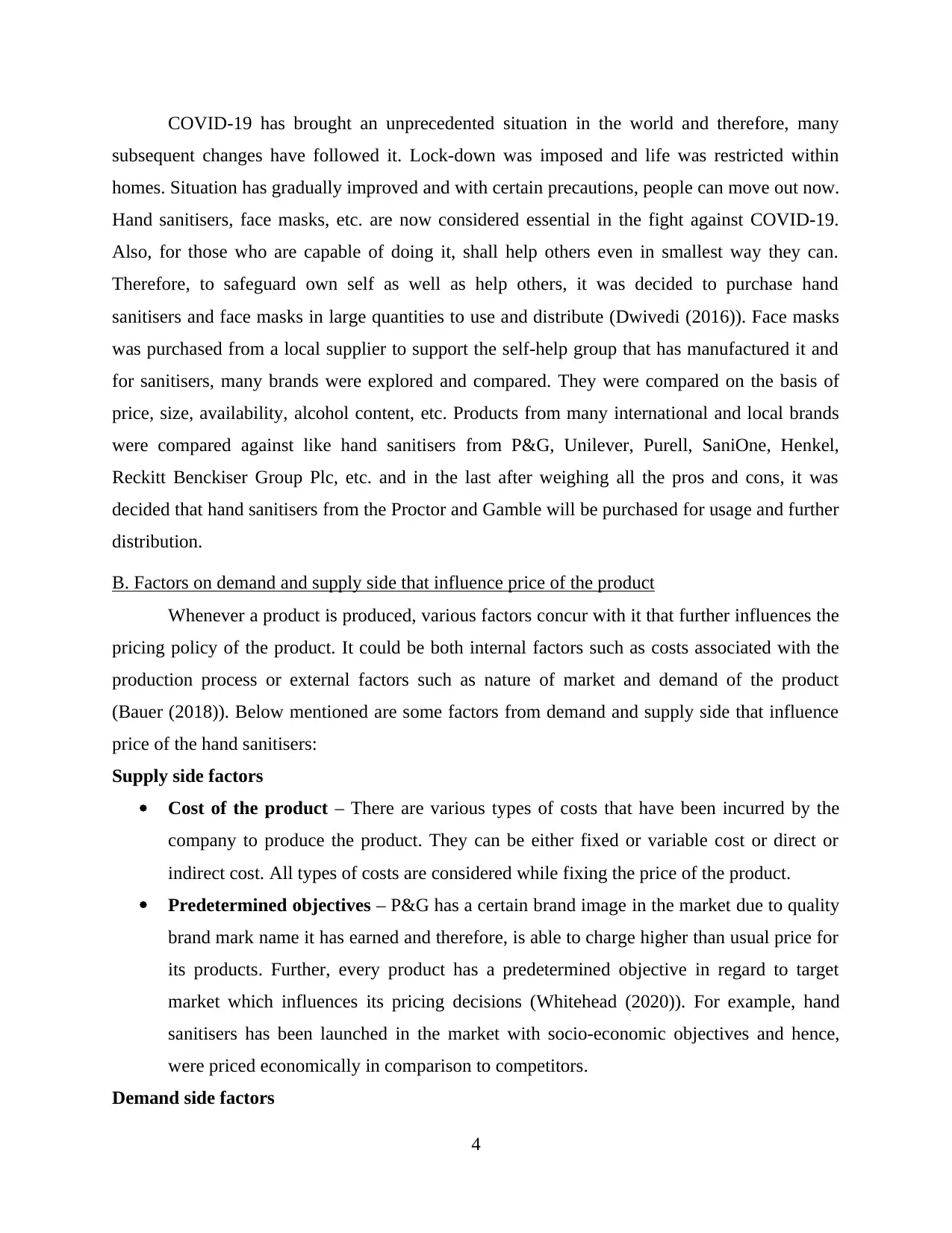
COVID-19 has brought an unprecedented situation in the world and therefore, many
subsequent changes have followed it. Lock-down was imposed and life was restricted within
homes. Situation has gradually improved and with certain precautions, people can move out now.
Hand sanitisers, face masks, etc. are now considered essential in the fight against COVID-19.
Also, for those who are capable of doing it, shall help others even in smallest way they can.
Therefore, to safeguard own self as well as help others, it was decided to purchase hand
sanitisers and face masks in large quantities to use and distribute (Dwivedi (2016)). Face masks
was purchased from a local supplier to support the self-help group that has manufactured it and
for sanitisers, many brands were explored and compared. They were compared on the basis of
price, size, availability, alcohol content, etc. Products from many international and local brands
were compared against like hand sanitisers from P&G, Unilever, Purell, SaniOne, Henkel,
Reckitt Benckiser Group Plc, etc. and in the last after weighing all the pros and cons, it was
decided that hand sanitisers from the Proctor and Gamble will be purchased for usage and further
distribution.
B. Factors on demand and supply side that influence price of the product
Whenever a product is produced, various factors concur with it that further influences the
pricing policy of the product. It could be both internal factors such as costs associated with the
production process or external factors such as nature of market and demand of the product
(Bauer (2018)). Below mentioned are some factors from demand and supply side that influence
price of the hand sanitisers:
Supply side factors
Cost of the product – There are various types of costs that have been incurred by the
company to produce the product. They can be either fixed or variable cost or direct or
indirect cost. All types of costs are considered while fixing the price of the product.
Predetermined objectives – P&G has a certain brand image in the market due to quality
brand mark name it has earned and therefore, is able to charge higher than usual price for
its products. Further, every product has a predetermined objective in regard to target
market which influences its pricing decisions (Whitehead (2020)). For example, hand
sanitisers has been launched in the market with socio-economic objectives and hence,
were priced economically in comparison to competitors.
Demand side factors
4
subsequent changes have followed it. Lock-down was imposed and life was restricted within
homes. Situation has gradually improved and with certain precautions, people can move out now.
Hand sanitisers, face masks, etc. are now considered essential in the fight against COVID-19.
Also, for those who are capable of doing it, shall help others even in smallest way they can.
Therefore, to safeguard own self as well as help others, it was decided to purchase hand
sanitisers and face masks in large quantities to use and distribute (Dwivedi (2016)). Face masks
was purchased from a local supplier to support the self-help group that has manufactured it and
for sanitisers, many brands were explored and compared. They were compared on the basis of
price, size, availability, alcohol content, etc. Products from many international and local brands
were compared against like hand sanitisers from P&G, Unilever, Purell, SaniOne, Henkel,
Reckitt Benckiser Group Plc, etc. and in the last after weighing all the pros and cons, it was
decided that hand sanitisers from the Proctor and Gamble will be purchased for usage and further
distribution.
B. Factors on demand and supply side that influence price of the product
Whenever a product is produced, various factors concur with it that further influences the
pricing policy of the product. It could be both internal factors such as costs associated with the
production process or external factors such as nature of market and demand of the product
(Bauer (2018)). Below mentioned are some factors from demand and supply side that influence
price of the hand sanitisers:
Supply side factors
Cost of the product – There are various types of costs that have been incurred by the
company to produce the product. They can be either fixed or variable cost or direct or
indirect cost. All types of costs are considered while fixing the price of the product.
Predetermined objectives – P&G has a certain brand image in the market due to quality
brand mark name it has earned and therefore, is able to charge higher than usual price for
its products. Further, every product has a predetermined objective in regard to target
market which influences its pricing decisions (Whitehead (2020)). For example, hand
sanitisers has been launched in the market with socio-economic objectives and hence,
were priced economically in comparison to competitors.
Demand side factors
4
Secure Best Marks with AI Grader
Need help grading? Try our AI Grader for instant feedback on your assignments.
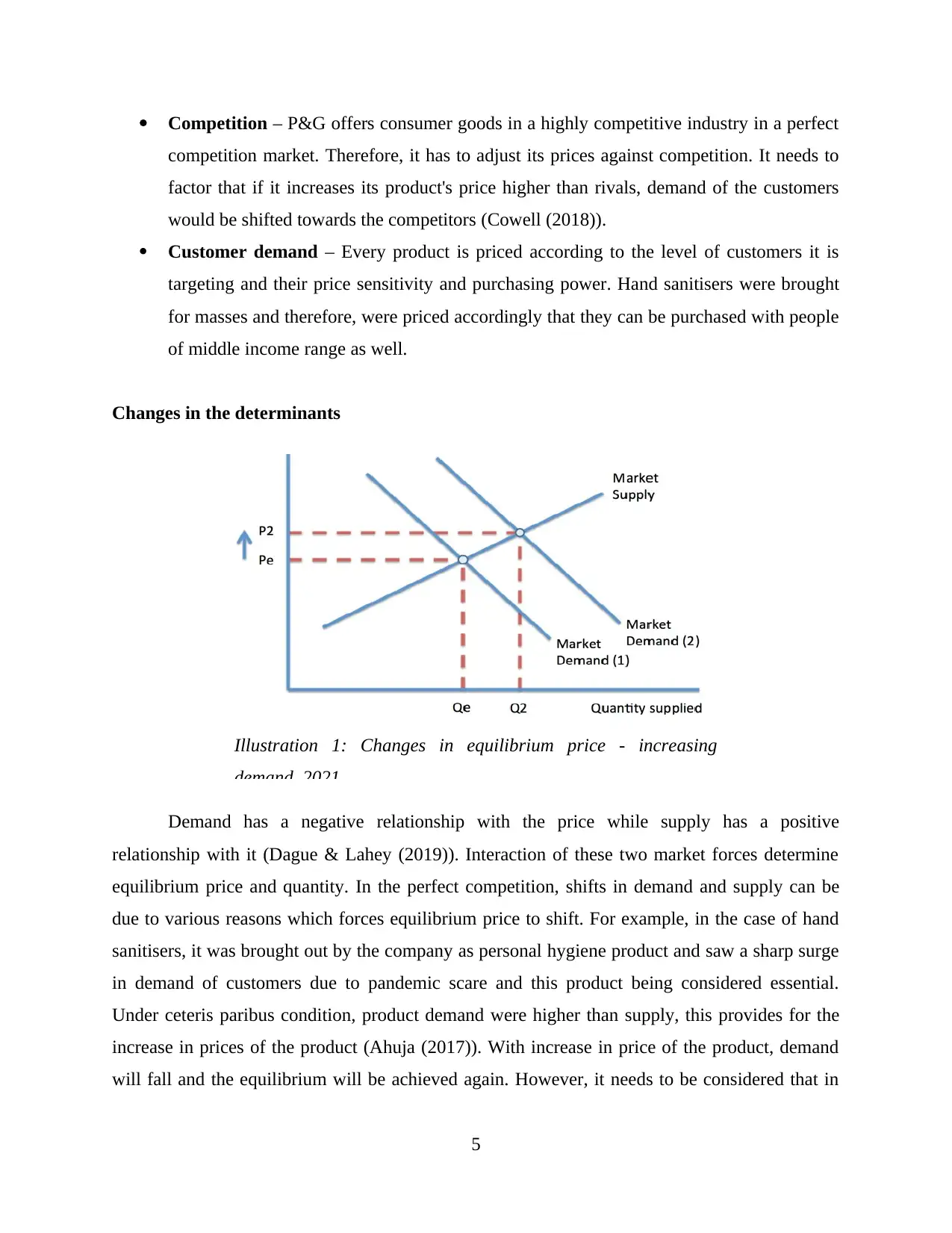
Competition – P&G offers consumer goods in a highly competitive industry in a perfect
competition market. Therefore, it has to adjust its prices against competition. It needs to
factor that if it increases its product's price higher than rivals, demand of the customers
would be shifted towards the competitors (Cowell (2018)).
Customer demand – Every product is priced according to the level of customers it is
targeting and their price sensitivity and purchasing power. Hand sanitisers were brought
for masses and therefore, were priced accordingly that they can be purchased with people
of middle income range as well.
Changes in the determinants
Demand has a negative relationship with the price while supply has a positive
relationship with it (Dague & Lahey (2019)). Interaction of these two market forces determine
equilibrium price and quantity. In the perfect competition, shifts in demand and supply can be
due to various reasons which forces equilibrium price to shift. For example, in the case of hand
sanitisers, it was brought out by the company as personal hygiene product and saw a sharp surge
in demand of customers due to pandemic scare and this product being considered essential.
Under ceteris paribus condition, product demand were higher than supply, this provides for the
increase in prices of the product (Ahuja (2017)). With increase in price of the product, demand
will fall and the equilibrium will be achieved again. However, it needs to be considered that in
5
Illustration 1: Changes in equilibrium price - increasing
demand, 2021
competition market. Therefore, it has to adjust its prices against competition. It needs to
factor that if it increases its product's price higher than rivals, demand of the customers
would be shifted towards the competitors (Cowell (2018)).
Customer demand – Every product is priced according to the level of customers it is
targeting and their price sensitivity and purchasing power. Hand sanitisers were brought
for masses and therefore, were priced accordingly that they can be purchased with people
of middle income range as well.
Changes in the determinants
Demand has a negative relationship with the price while supply has a positive
relationship with it (Dague & Lahey (2019)). Interaction of these two market forces determine
equilibrium price and quantity. In the perfect competition, shifts in demand and supply can be
due to various reasons which forces equilibrium price to shift. For example, in the case of hand
sanitisers, it was brought out by the company as personal hygiene product and saw a sharp surge
in demand of customers due to pandemic scare and this product being considered essential.
Under ceteris paribus condition, product demand were higher than supply, this provides for the
increase in prices of the product (Ahuja (2017)). With increase in price of the product, demand
will fall and the equilibrium will be achieved again. However, it needs to be considered that in
5
Illustration 1: Changes in equilibrium price - increasing
demand, 2021
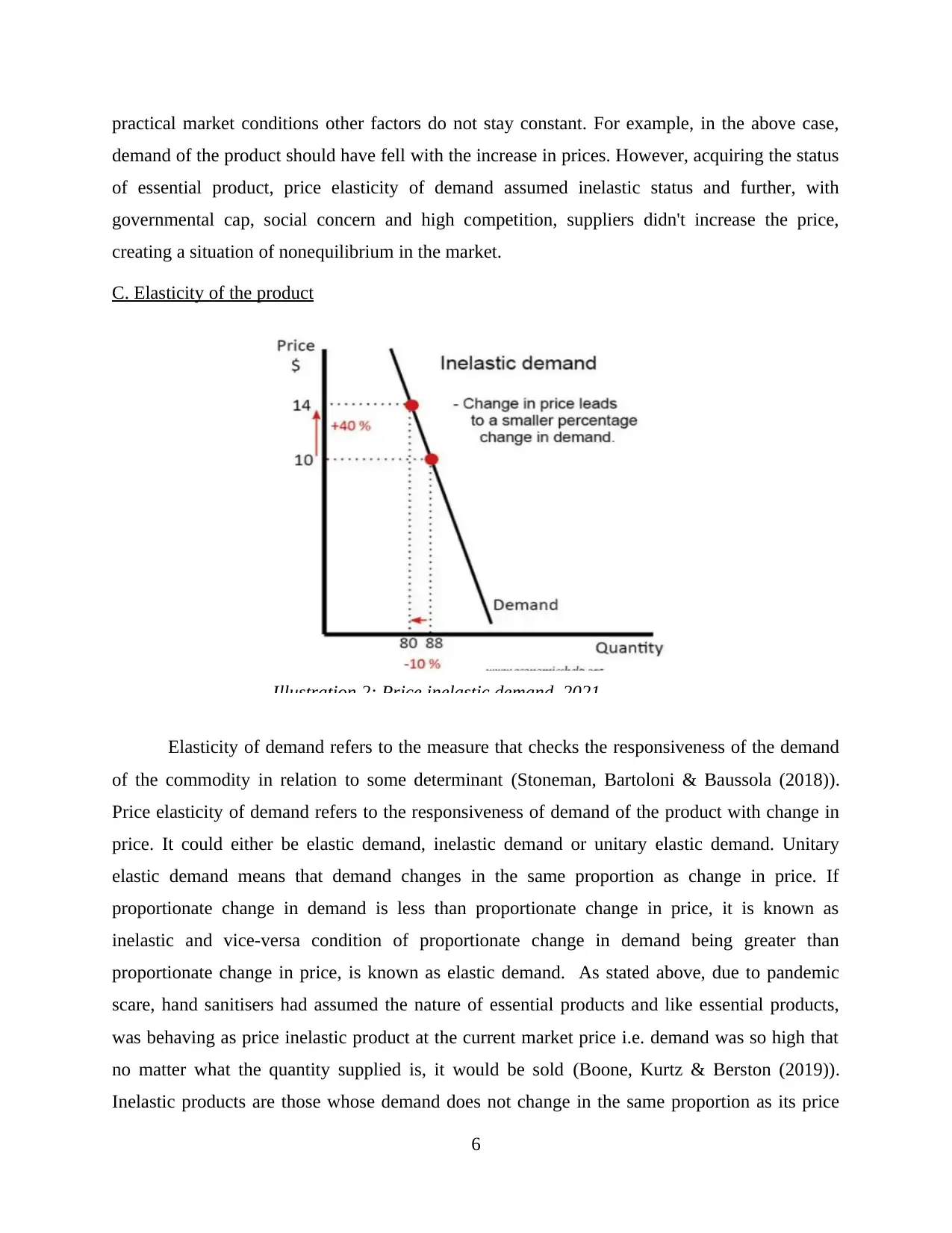
practical market conditions other factors do not stay constant. For example, in the above case,
demand of the product should have fell with the increase in prices. However, acquiring the status
of essential product, price elasticity of demand assumed inelastic status and further, with
governmental cap, social concern and high competition, suppliers didn't increase the price,
creating a situation of nonequilibrium in the market.
C. Elasticity of the product
Elasticity of demand refers to the measure that checks the responsiveness of the demand
of the commodity in relation to some determinant (Stoneman, Bartoloni & Baussola (2018)).
Price elasticity of demand refers to the responsiveness of demand of the product with change in
price. It could either be elastic demand, inelastic demand or unitary elastic demand. Unitary
elastic demand means that demand changes in the same proportion as change in price. If
proportionate change in demand is less than proportionate change in price, it is known as
inelastic and vice-versa condition of proportionate change in demand being greater than
proportionate change in price, is known as elastic demand. As stated above, due to pandemic
scare, hand sanitisers had assumed the nature of essential products and like essential products,
was behaving as price inelastic product at the current market price i.e. demand was so high that
no matter what the quantity supplied is, it would be sold (Boone, Kurtz & Berston (2019)).
Inelastic products are those whose demand does not change in the same proportion as its price
6
Illustration 2: Price inelastic demand, 2021
demand of the product should have fell with the increase in prices. However, acquiring the status
of essential product, price elasticity of demand assumed inelastic status and further, with
governmental cap, social concern and high competition, suppliers didn't increase the price,
creating a situation of nonequilibrium in the market.
C. Elasticity of the product
Elasticity of demand refers to the measure that checks the responsiveness of the demand
of the commodity in relation to some determinant (Stoneman, Bartoloni & Baussola (2018)).
Price elasticity of demand refers to the responsiveness of demand of the product with change in
price. It could either be elastic demand, inelastic demand or unitary elastic demand. Unitary
elastic demand means that demand changes in the same proportion as change in price. If
proportionate change in demand is less than proportionate change in price, it is known as
inelastic and vice-versa condition of proportionate change in demand being greater than
proportionate change in price, is known as elastic demand. As stated above, due to pandemic
scare, hand sanitisers had assumed the nature of essential products and like essential products,
was behaving as price inelastic product at the current market price i.e. demand was so high that
no matter what the quantity supplied is, it would be sold (Boone, Kurtz & Berston (2019)).
Inelastic products are those whose demand does not change in the same proportion as its price
6
Illustration 2: Price inelastic demand, 2021
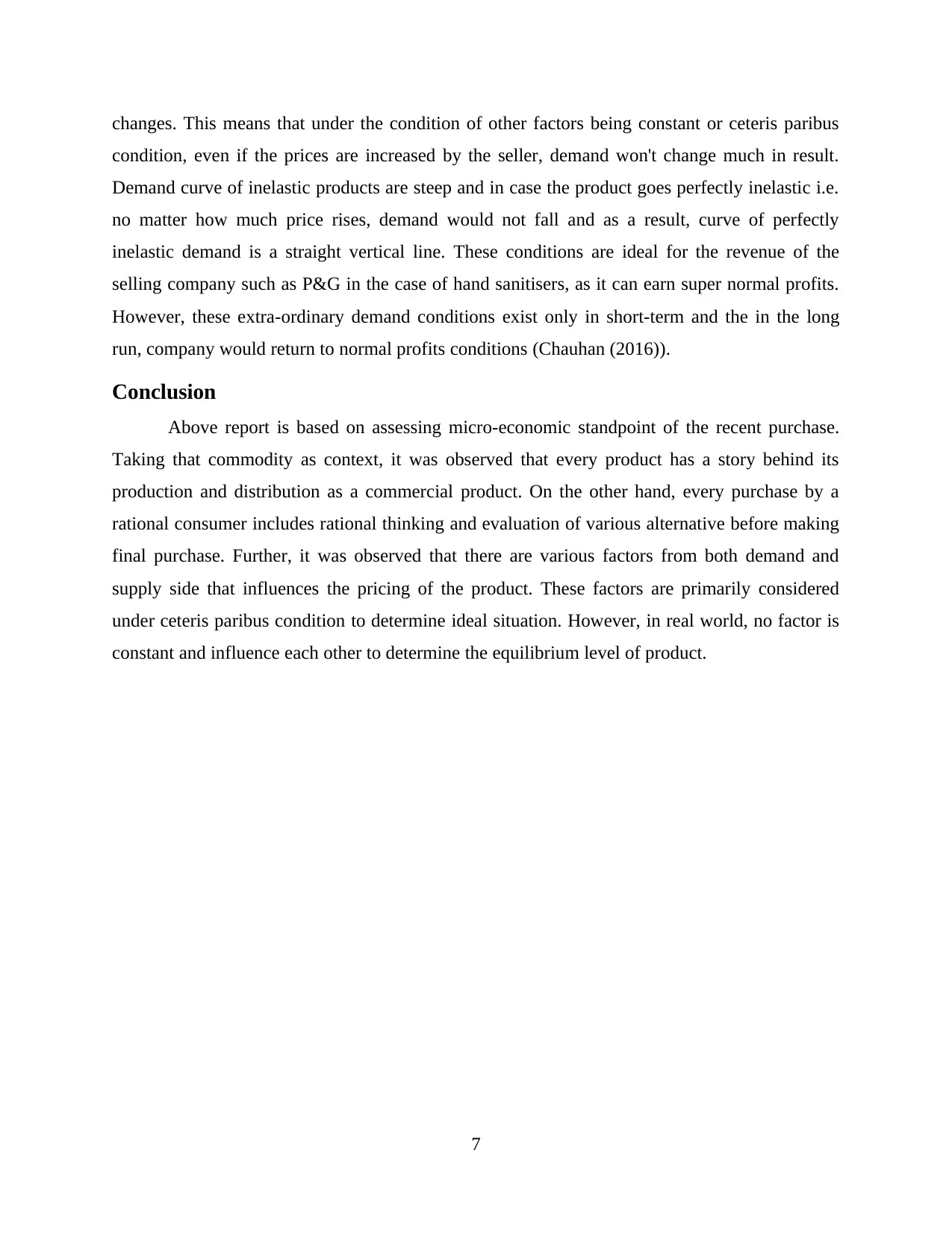
changes. This means that under the condition of other factors being constant or ceteris paribus
condition, even if the prices are increased by the seller, demand won't change much in result.
Demand curve of inelastic products are steep and in case the product goes perfectly inelastic i.e.
no matter how much price rises, demand would not fall and as a result, curve of perfectly
inelastic demand is a straight vertical line. These conditions are ideal for the revenue of the
selling company such as P&G in the case of hand sanitisers, as it can earn super normal profits.
However, these extra-ordinary demand conditions exist only in short-term and the in the long
run, company would return to normal profits conditions (Chauhan (2016)).
Conclusion
Above report is based on assessing micro-economic standpoint of the recent purchase.
Taking that commodity as context, it was observed that every product has a story behind its
production and distribution as a commercial product. On the other hand, every purchase by a
rational consumer includes rational thinking and evaluation of various alternative before making
final purchase. Further, it was observed that there are various factors from both demand and
supply side that influences the pricing of the product. These factors are primarily considered
under ceteris paribus condition to determine ideal situation. However, in real world, no factor is
constant and influence each other to determine the equilibrium level of product.
7
condition, even if the prices are increased by the seller, demand won't change much in result.
Demand curve of inelastic products are steep and in case the product goes perfectly inelastic i.e.
no matter how much price rises, demand would not fall and as a result, curve of perfectly
inelastic demand is a straight vertical line. These conditions are ideal for the revenue of the
selling company such as P&G in the case of hand sanitisers, as it can earn super normal profits.
However, these extra-ordinary demand conditions exist only in short-term and the in the long
run, company would return to normal profits conditions (Chauhan (2016)).
Conclusion
Above report is based on assessing micro-economic standpoint of the recent purchase.
Taking that commodity as context, it was observed that every product has a story behind its
production and distribution as a commercial product. On the other hand, every purchase by a
rational consumer includes rational thinking and evaluation of various alternative before making
final purchase. Further, it was observed that there are various factors from both demand and
supply side that influences the pricing of the product. These factors are primarily considered
under ceteris paribus condition to determine ideal situation. However, in real world, no factor is
constant and influence each other to determine the equilibrium level of product.
7
Paraphrase This Document
Need a fresh take? Get an instant paraphrase of this document with our AI Paraphraser
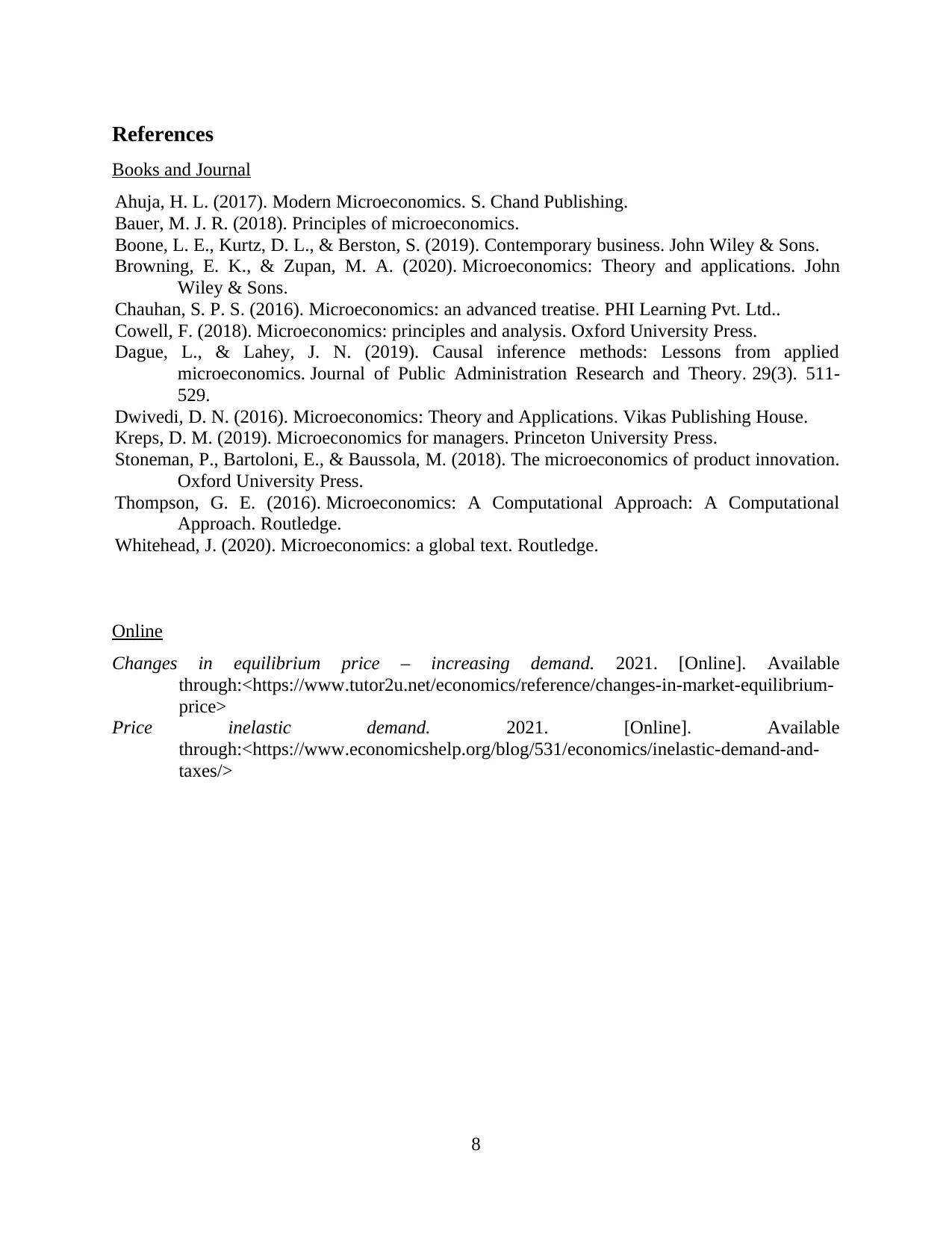
References
Books and Journal
Ahuja, H. L. (2017). Modern Microeconomics. S. Chand Publishing.
Bauer, M. J. R. (2018). Principles of microeconomics.
Boone, L. E., Kurtz, D. L., & Berston, S. (2019). Contemporary business. John Wiley & Sons.
Browning, E. K., & Zupan, M. A. (2020). Microeconomics: Theory and applications. John
Wiley & Sons.
Chauhan, S. P. S. (2016). Microeconomics: an advanced treatise. PHI Learning Pvt. Ltd..
Cowell, F. (2018). Microeconomics: principles and analysis. Oxford University Press.
Dague, L., & Lahey, J. N. (2019). Causal inference methods: Lessons from applied
microeconomics. Journal of Public Administration Research and Theory. 29(3). 511-
529.
Dwivedi, D. N. (2016). Microeconomics: Theory and Applications. Vikas Publishing House.
Kreps, D. M. (2019). Microeconomics for managers. Princeton University Press.
Stoneman, P., Bartoloni, E., & Baussola, M. (2018). The microeconomics of product innovation.
Oxford University Press.
Thompson, G. E. (2016). Microeconomics: A Computational Approach: A Computational
Approach. Routledge.
Whitehead, J. (2020). Microeconomics: a global text. Routledge.
Online
Changes in equilibrium price – increasing demand. 2021. [Online]. Available
through:<https://www.tutor2u.net/economics/reference/changes-in-market-equilibrium-
price>
Price inelastic demand. 2021. [Online]. Available
through:<https://www.economicshelp.org/blog/531/economics/inelastic-demand-and-
taxes/>
8
Books and Journal
Ahuja, H. L. (2017). Modern Microeconomics. S. Chand Publishing.
Bauer, M. J. R. (2018). Principles of microeconomics.
Boone, L. E., Kurtz, D. L., & Berston, S. (2019). Contemporary business. John Wiley & Sons.
Browning, E. K., & Zupan, M. A. (2020). Microeconomics: Theory and applications. John
Wiley & Sons.
Chauhan, S. P. S. (2016). Microeconomics: an advanced treatise. PHI Learning Pvt. Ltd..
Cowell, F. (2018). Microeconomics: principles and analysis. Oxford University Press.
Dague, L., & Lahey, J. N. (2019). Causal inference methods: Lessons from applied
microeconomics. Journal of Public Administration Research and Theory. 29(3). 511-
529.
Dwivedi, D. N. (2016). Microeconomics: Theory and Applications. Vikas Publishing House.
Kreps, D. M. (2019). Microeconomics for managers. Princeton University Press.
Stoneman, P., Bartoloni, E., & Baussola, M. (2018). The microeconomics of product innovation.
Oxford University Press.
Thompson, G. E. (2016). Microeconomics: A Computational Approach: A Computational
Approach. Routledge.
Whitehead, J. (2020). Microeconomics: a global text. Routledge.
Online
Changes in equilibrium price – increasing demand. 2021. [Online]. Available
through:<https://www.tutor2u.net/economics/reference/changes-in-market-equilibrium-
price>
Price inelastic demand. 2021. [Online]. Available
through:<https://www.economicshelp.org/blog/531/economics/inelastic-demand-and-
taxes/>
8
1 out of 8
Related Documents
Your All-in-One AI-Powered Toolkit for Academic Success.
+13062052269
info@desklib.com
Available 24*7 on WhatsApp / Email
![[object Object]](/_next/static/media/star-bottom.7253800d.svg)
Unlock your academic potential
© 2024 | Zucol Services PVT LTD | All rights reserved.
